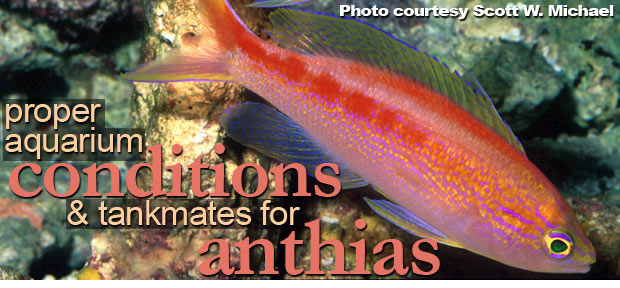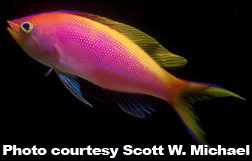Keeping the Jewels of the Reef:
The Anthias of the Genus Pseudanthias - Part 4
By Scott W. Michael Anthias appreciate strong current and clean, well-oxygenated water. Water movement may also help discourage aggression in these fish. For example, it has been demonstrated in the Lyretail Anthias inter-individual distances decrease when currents are strong and increase when they're slack. Anthias also make great "dither" fish, especially those species that spend lots of time swimming high in the water column. Dither fish are species that spend their time in the open and by doing so they incite more nervous species to spend time in the open. Anthias are often quite frenetic when first added to the tank. Sudden changes in their environment, like a light suddenly turning off or on or an aquarist's hand plunging into the tank can lead to some spectacular anthias aerial displays! Aggressive tankmates can also be a curse to newly acquired anthias. I have seen dottybacks, angelfishes, hawkfishes and larger damsels pester these fish to the point of death.
Although anthias are not suitable for every aquarium venue, there are species within this subfamily that consistently do well in the home aquarium. I hope the tips presented here will help you in your efforts to keep one or more of these amazing fishes.
 Scott Michael
Scott MichaelScott W. Michael is an internationally-recognized writer, underwater photographer, and marine biology researcher specializing in reef fishes, and was the Banquet Speaker at our 2007 and 2008 Coral Conference and Frag Swap. He is a regular contributor to Aquarium Fish Magazine, Freshwater and Marine Aquarium Magazine, SeaScope, and is the author of Reef Fishes Vol 1, Vol 2, and Vol 3, Vol 4, and Vol 5., A Pocket Expert Guide Marine Fishes, A Pocket Expert Guide to Reef Aquarium Fishes, 101 Best Saltwater Fishes: How to Choose and Keep Hardy, Brilliant, Fascinating Species That Will Thrive in Your Home Aquarium, Reef Sharks & Rays of the World, and Aquarium Sharks & Rays. Having studied marine biology at the University of Nebraska, Scott has served as a scientific consultant for National Geographic Explorer, the Discovery Channel, and French educational television. |
|||||||||
|
|





